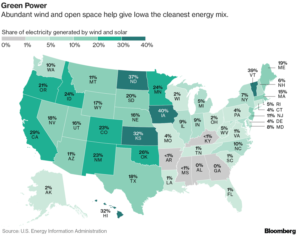By David Gardiner, President of David Gardiner and Associates
This Fall, I participated in two clean energy conferences in the Great Plains: the 10th annual Nebraska Wind & Solar Conference and the 2017 Kansas Energy Conference. Those events provided a fresh reminder that renewable energy is becoming a dominant player in the breadbasket of America. Kansas produces 32 percent of its electricity from renewables, while Nebraska produces 16 percent. As the map illustrates, the top five states with the greatest percentage of wind and solar in their energy mix are Iowa (40%), Vermont (39%), North Dakota (37%), Kansas (32%), and California (29%). I suspect these numbers might surprise some who think most renewable energy leadership has come from states on the East and West Coasts.
of wind and solar in their energy mix are Iowa (40%), Vermont (39%), North Dakota (37%), Kansas (32%), and California (29%). I suspect these numbers might surprise some who think most renewable energy leadership has come from states on the East and West Coasts.
There were several common themes from the two conferences.
First, the rooms were filled with a diverse array of parties aiming to seize the economic development potential of renewable energy: utilities, renewable energy business owners, state economic development agencies, environmental advocates, and other energy experts. Kansas Governor Sam Brownback called the renewable energy expansion in the last six years “the greatest rural economic development program” his state had ever seen.
Second, the rising tide of renewable energy procurement by Fortune 500 companies was a central focus of the discussions. The Nebraska conference, for example, spotlighted a recent agreement for the Omaha Public Power District (OPPD) to power Facebook’s new Papillion data center with 100% renewable electricity through a green tariff program. Using OPPD’s electric rate structure–Rate 261M–Facebook will be purchasing 200 MW of wind capacity from Enel Green Power North America’s (EGPNA) 320 MW Rattlesnake Creek wind farm. OPPD also announced plans to make renewables 50% of the total electricity they sell to customers by 2020; the mix was less that 20% in 2016.
In Kansas, the conference examined the renewable electricity demand from major local manufacturing factories, such as those owned by GM, and on the rising interest of companies in approaching renewable energy as a key factor in where they locate their facilities, as exemplified in the report from the retail and information technology trade associations, which ranked all 50 states on the degree to which they provide easy customer access to renewable energy. Indeed, in recognition of this rising demand, shortly after the conference, the local utility, Westar, proposed a new green tariff to allow large customers to purchase electricity from locally sourced wind generation.
Third, both conferences focused on the need for transmission to move renewable energy produced in these states to load centers in the rest of the country, just as we move the region’s agricultural products to market. Because most Fortune 500 companies have their operations outside the Great Plains, many of the energy projects in the Midwest sell electricity through off-site PPAs. These PPAs rely on transmission to get the renewable energy from where it’s produced to markets. It was a strong reminder of the critical role transmission must play in scaling up renewable energy and achieving the scale of carbon reductions scientists say we need.
Clean energy advocates from around the country should recognize the success states such as Kansas and Nebraska are already having scaling up renewable energy. Just as these breadbasket states feed America today, we should recognize they that will provide much of tomorrow’s clean power.
To learn more about this topic and other energy-related issues, please read more on www.dgardiner.com and follow us on Twitter: @dgardinera and @CustomerREVO
